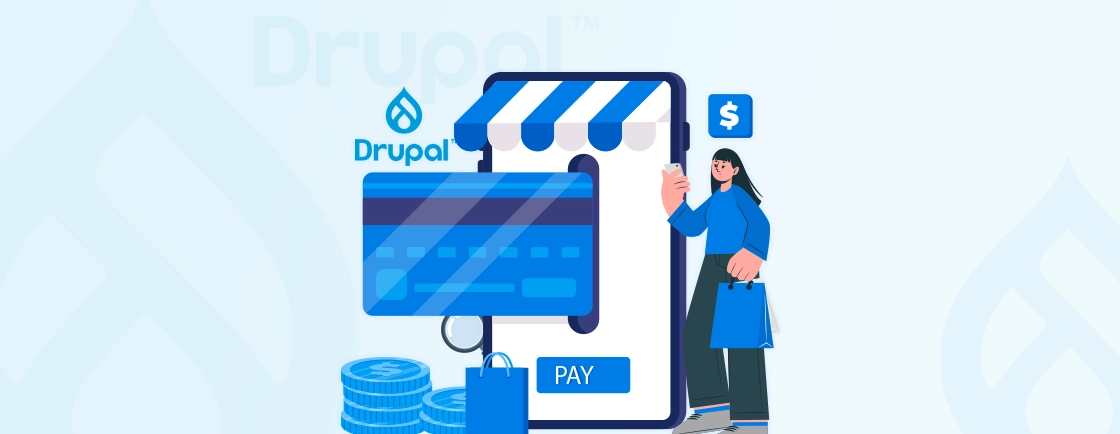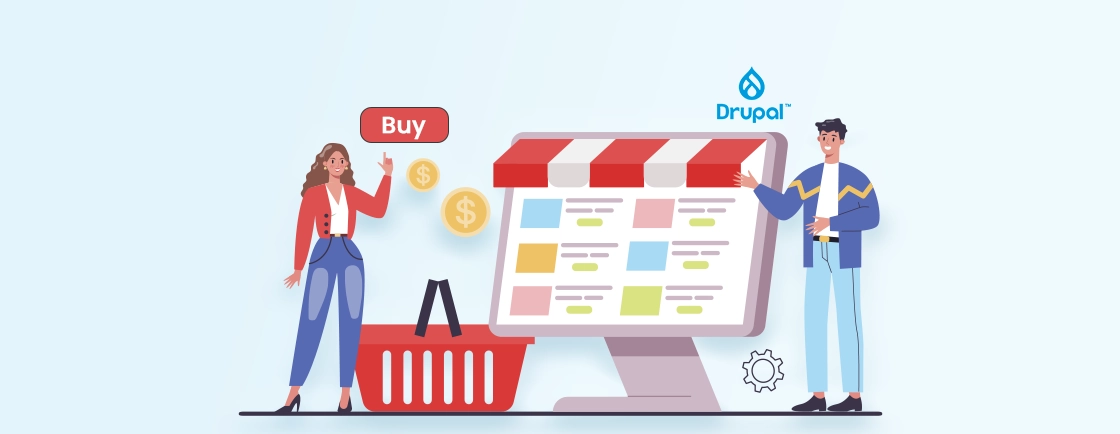Table of Contents
Thinking about taking your business to the next level by creating a bustling marketplace? It will connect buyers and sellers to create vibrant communities around specific products or services.
While Drupal excels at creating stunning websites, its true strength lies in its ability to be extended with modules. Building the marketplace in Drupal goes from choosing the modules to setting up the seamless UI/UX for both the vendors and customers.
Let’s find out.
What is a Marketplace?
A marketplace is a platform or website where multiple vendors or sellers can list and sell their products or services. Customers can browse through these listings, compare offerings, and make purchases directly from the sellers.
Drupal provides various modules and tools that can be used to create a marketplace, manage products, handle transactions, and more. Two of the most common Drupal modules used for building marketplaces include Drupal Commerce and Ubercart.
Key Features of a Drupal Marketplace
Drupal provides a powerful foundation for building a feature-rich marketplace that caters to both buyers and sellers. Here are some key functionalities to consider:
- Multi-vendor Support: Drupal allows you to manage multiple vendors, each with their own product listings, inventory, and profiles.
- Product Management: Vendors can easily add, edit, and manage their products with a user-friendly interface.
- Payments & Commissions: Integrate secure payment gateways and configure commission structures for vendors.
- Order Management: Track orders, fulfillments, and provide a smooth experience for both vendors and customers.
- Storefront Customization: Tailor the look and feel of your marketplace to match your brand identity.
- Vendor Reviews & Ratings: Enable customer reviews and ratings to build trust and credibility for vendors.
- Content Management: Integrate blog posts, informative articles, or other content to enhance your marketplace experience.
Drupal’s modular nature allows you to extend features and functionalities to fit your specific marketplace needs. So, consider opting for professional Drupal development services to ensure your platform is built scalable and secure.
Types of Marketplace
Marketplaces have become a dominant force in eCommerce, revolutionizing how we buy and sell. But with so many types of marketplace, it’s easy to get confused. Let’s delve into the most common types of marketplaces to understand their unique characteristics:
- Business-to-Consumer (B2C): This is the classic online marketplace model, where businesses sell directly to individual consumers. Think Amazon, eBay, or any store you visit online.
- Business-to-Business (B2B): Here, businesses connect with other businesses to buy and sell goods or services in larger quantities. Think of platforms that connect manufacturers with wholesalers or distributors.
- Consumer-to-Consumer (C2C): This model facilitates transactions between individual consumers. Popular examples include platforms like Etsy, where crafters sell their creations, or used goods marketplaces.
- Subscription-based: This model offers products or services through a recurring subscription fee. Subscription boxes, access to streaming services, or exclusive content platforms all fall under this category.
- Vertical Marketplaces: These cater to a specific niche or industry, offering a focused selection of products or services relevant to that niche. For example, a marketplace dedicated to musical instruments or sporting goods.
Understanding these types of marketplaces are advantageous for both buyers and sellers. Buyers can identify platforms that align with their needs. On the other hand, sellers can choose a marketplace that best suits their products or services, reaching a targeted audience.
So, the next time you delve into the world of online marketplaces, consider the type of platform you’re using. This awareness can lead to a more efficient and successful shopping or selling experience.
Why Build a Marketplace in Drupal?
Building a marketplace in Drupal offers several benefits from advanced customization options to built-in SEO optimization. That caters to a truly customized and scalable online experience. So, let’s dive into each of them in detail.
Advanced Customization Options
Drupal offers flexibility to assign unique user roles and permissions to custom product fields and storefront designs. So, you can create an interface that perfectly reflects your vision. This lets you cater to niche markets or implement unique features that set your platform apart.
Seamless Integration Capabilities
Drupal integrations connect your marketplace to various payment gateways, shipping providers, and even social media platforms. This ensures a smooth flow of transactions, data, and marketing efforts, streamlining workflow and enhanced user convenience.
Robust Security Features
Drupal’s renowned security architecture prioritizes the safety of your marketplace and user data. Regular security updates and data encryption ensure a secure environment for both buyers and sellers, building trust and confidence in your platform.
Responsive Design Elements
Drupal prioritizes device-independent experiences. Its responsive design ensures that your marketplace looks and functions flawlessly across desktops, tablets, and smartphones. This adaptability serves the ever-growing mobile user base providing a seamless experience for everyone.
Built-in SEO Optimization
Drupal core functionalities and dedicated SEO modules empower you to optimize your marketplace for search engines. It includes clean URL structures, meta descriptions, and content management tools that help you create compelling product descriptions and blog posts. Ultimately driving organic traffic and boosting your marketplace’s visibility.
To leverage these benefits, we recommend to hire dedicated Drupal developers. They will help build a marketplace that is not only secure but also aligns with your unique needs.
How to Build a Marketplace in Drupal?
Transforming your vision into a thriving online marketplace requires a solid foundation in Drupal expertise. Drupal, with its modules and extensive features, empowers you to build a platform that caters to both buyers and sellers.
Here’s a breakdown of the key steps involved:
Step 1: Install Drupal and Required Modules
Before diving into marketplace specifics, we need to get the prerequisite requirements fulfilled. This initial step involves various installations like:
- Installing Drupal Core: Download and install the latest version of Drupal to create the core framework for your marketplace.
- Enabling Commerce Module: Drupal Commerce is the essential module that unlocks the e-commerce functionalities within your Drupal site.
- Installing Additional Modules: Depending on your specific marketplace needs, consider adding modules like Commerce Marketplace, payment gateways, shipping providers, and SEO tools. These modules will enhance your marketplace’s capabilities and streamline various functionalities.
With these initial preparations in place, you’re ready to move on to configuring your marketplace’s core settings.
Step 2: Configure Marketplace Settings
Once the foundation is laid, it’s time to fine-tune the core functionalities of your marketplace. This step involves:
- Store Settings: Define the overall parameters that govern your marketplace, including currency, tax rules, order processing, and shipping configurations. These settings establish the framework for financial transactions and product delivery within your platform.
- Vendor Management: Configure the processes for vendor registration, product listing, and commission structures. This ensures a streamlined onboarding process for sellers and establishes clear guidelines for their participation in your marketplace.
- Product Display: Set up product categories, and search functionalities to optimize product browsing and discovery for buyers. This enhances user experience and facilitates efficient product navigation within your marketplace.
By configuring these settings, you complete the groundwork for a smooth-running marketplace that caters to both buyers and sellers effectively.
Step 3: Create User Roles and Permissions
Along with the core settings, it’s crucial to establish a clear hierarchy within your marketplace. This step involves:
- Defining User Roles: Create distinct user roles for buyers, sellers, administrators, and other relevant actors within your marketplace. That ensures that each user has access to the functionalities and information relevant to their role.
- Assigning Permissions: Assign specific permissions to each user role, controlling access to product listings, order management, and other functionalities. This establishes clear boundaries and safeguards the integrity of your marketplace.
Defining user roles and permissions, makes the marketplace a secure and organized environment. So, users operate within their designated scope, contributing to the overall functionality of your marketplace.
Step 4: Design and Customize the Marketplace
Now that the core functionalities are established, it’s time to bring your vision to life. This step focuses on the visual and user experience aspects of your marketplace:
- Choosing a Theme: Select a visually appealing and user-friendly Drupal theme aligning with your brand identity and target audience. A well-chosen theme sets the overall tone and creates a positive first impression for your marketplace visitors.
- Customizing Storefront Design: Create layout, product listings, and overall user experience to match your vision. This includes elements like display formats, search functionalities, and checkout processes.
- Content Creation: Create informative content like product descriptions, and blog posts to increase engagement and SEO. Product descriptions attract buyers, while informative content builds trust and establishes your marketplace as a valuable resource.
By designing and customizing your marketplace, you create a user-friendly platform that builds a positive user experience and ensures user retention. Proper server environment setup with PHP extensions and a supported web server is essential when learning how to install Drupal Commerce successfully without errors.
Step 5: Add Products and Services
With the groundwork laid and the storefront designed, it’s time to add products and services to your marketplace for attracting buyers. This step involves:
- Vendor Onboarding: Help sellers listing products, ensuring product information accuracy and adherence to your marketplace guidelines. This creates a foundation for high-quality product listings and a positive user experience.
- Product Management: Allow sellers to add, edit, and manage their product listings, including descriptions, images, and pricing. This empowers sellers to take ownership of their product offerings and maintain right information for potential buyers.
Providing this facility of product addition and management process, you can ensure a diverse and well-maintained selection of products within your marketplace.
Step 6: Set Up Payment and Shipping Options
Finally, it’s crucial to establish seamless payment and shipping processes to facilitate smooth transactions within your marketplace. This step involves:
- Payment Gateways: Establish secure payment gateways like integrating braintree with Drupal to enable buyers to pay for their purchases seamlessly. This ensures a secure and convenient payment experience for your customers.
- Shipping Configurations: Define shipping methods, rates, and delivery zones to provide clear options to your customers. This allows buyers to choose the most suitable shipping option based on their needs and preferences.
With this, you ensure secure payment and shipping options that build trust with your buyers and ensure them a better purchasing experience within your marketplace.
But if you want more customization and personalized websites, hire Drupal developers. We’ll take your requirements
Challenges in Building a Marketplace in Drupal
While Drupal offers a powerful platform for building marketplaces, it has its challenges. Here are some key challenges to consider as you start building a marketplace in Drupal.
Complexity of Set-up
Drupal offers a wide range of features and modules, which can be overwhelming for beginners. Understanding the core functionalities and choosing the right combination of modules requires careful planning and research.
Customization Requirements
Building a unique and user-friendly marketplace experience might require creating custom modules. For that, you may need assistance from professional marketplace development services.
Security Concerns
As a platform handling sensitive user data and financial transactions, security is crucial. Regular updates to Drupal core and modules are important to address potential vulnerabilities.
Despite these challenges, by carefully planning and hiring Drupal developers you can overcome them and create a scalable and robust marketplace. Drupal eCommerce development supports multi-vendor marketplaces, subscription services, and digital downloads, making it a solution for diverse needs.
Conclusion
Building a marketplace in Drupal unlocks an ocean of possibilities. From extensive customization options to robust security features. While challenges exist, careful planning and leveraging the marketplace can help you reach a wider audience.
With careful planning, the right tools, and the power of Drupal, your vision of a flourishing online marketplace can become a reality. For a complex marketplace or a faster time-to-market, consider hiring Drupal experts for a more streamlined process!
FAQs About Building Your Marketplace in Drupal
How do I customize the look and feel of my marketplace?
Drupal offers a wide range of themes you can choose from. Themes can be further customized through layouts, colors, and CSS to meet your brand identity.
Is Drupal a secure platform for building a marketplace?
Yes, Drupal is a highly secure platform for building a marketplace website. It follows strict coding standards and regular security updates to ensure the safety of your website and its data.
Can I integrate third-party payment gateways into my Drupal marketplace website?
Yes, Drupal offers various modules that allow you to integrate third-party payment gateways such as braintree, and paypal into your marketplace. That makes it easy for your customers to make secure payments for their purchases.
Unleash the Potential of Drupal
Access expert guides and insights to leverage Drupal for scalable and secure web solutions.





